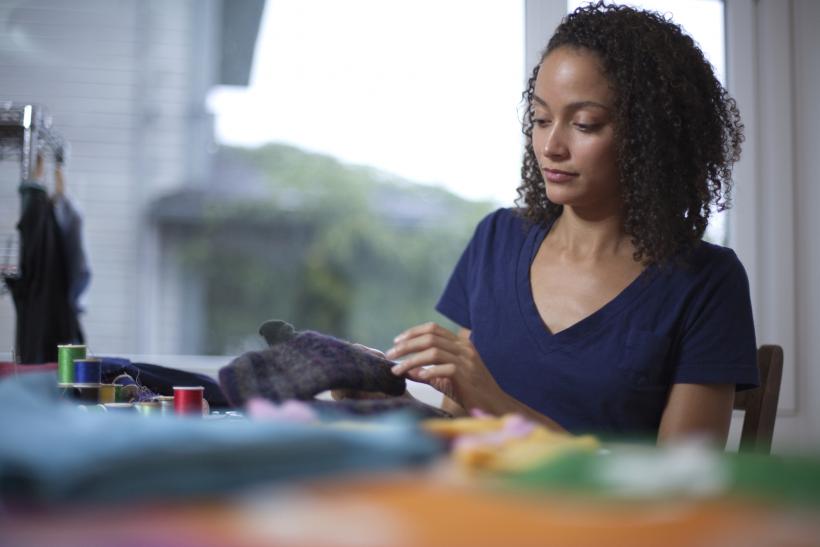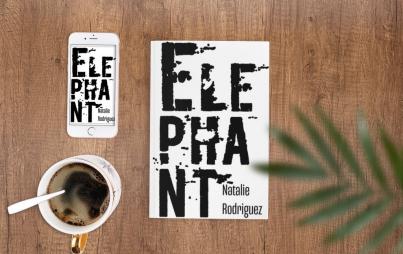
I’ve found that, when you’re depressed, keeping your hands and mind busy can be a lifeline. Image: Thinkstock
Even when you’re a teary mess, you can still create something beautiful.
The inimitable Alice Walker said, “When you are creating beauty around you, you are restoring your own soul.”
I doubt she was talking about using DIY as a self-care method, but her words still apply here. As someone with multiple mental illnesses, I truly believe that crafting has soul-restoring properties.
You know the saying, “Idle hands are the devil’s workshop”? I’m not sure if that’s true, but idle minds are certainly depression’s workshop.
For a long time, I used to think taking time off to do nothing was a great self-care method — until I realized boredom meant my depressive thoughts would only marinate in my head and push me further down that depressive path.
I’ve found that, when you’re depressed, keeping your hands and mind busy can be a lifeline.
Unlike watching series or sleeping, crafts actually engage your brain. They can give you an amazing sense of self-accomplishment when mental illness eclipses your confidence.
Science backs me up on this one. Research has indicated that crafts like knitting can aide mindfulness and relaxation, and neuroscientists have found that handiwork releases dopamine, making it a useful method for treating depression.
So how can you integrate crafts into a self-care routine? Here are a few tips:
1. Use repetitive crafts to distract yourself from anxiety and triggers.
Years of experience have taught me that distraction can be the best way to deal with anxiety.
Anxiety can flood your mind with terrifying possibilities and painful memories, so much that it’s hard to know what to do with yourself. Tackling the underlying causes of your anxiety is a difficult task when your mind's abuzz with overwhelming thoughts.
Because of this, my self-care regime includes distraction as the first response to anxiety. Once I’ve distracted myself from the anxiety, and I’m in a calmer place, I can tackle the cause.
The same goes for triggers. As someone with PTSD, I find that distracting myself can be a helpful way to stop flashbacks and intrusive thoughts.
Try a repetitive craft like knitting or coloring. The repetitive actions — in this case, the movement of yarn or the strokes of a pencil — can feel incredibly calming. It requires a little bit of concentration, but not a whole lot of brain work.
This means it’s a great form of distraction, but it’s not too difficult to handle.
2. Watch YouTube tutorials when you feel unmotivated and uninspired.
I think one of the most annoying things about depression is that it steals your motivation.
And although I often find it really easy to get excited about crafts, sometimes my depression steals away my excitement for that, too.
If this happens to you, allow others to inspire and excite you. Tutorials can be a great stepping stone to actually doing crafts or other creative things when you’re feeling too unmotivated to deal.
I find that when I watch tutorials, I’m still engaging my brain, because I’m constantly talking to myself: Do I have those supplies? Hey, I could make that. Wait, why are they sewing like that? Ah, I see! Ooh, maybe I could do the same cushion, but with a penguin template instead of a sloth. Damn, that’s cool. Hey! I could totally make that.
At the same time, if I’m feeling low, watching a video seems a lot more possible than creating an entire thing.
One of my favorite crafty YouTubers is Lauren Dixon-Paver, who makes everything from plush hedgehogs to tattoo chokers and superhero cushions. Her tutorials are simple enough for beginners to follow.
If you’re not into YouTube, look for image-and-text tutorials online. Check out Instructables. Many publications, including The Lala and Autostraddle, have their own DIY sections, too.
And also, Pinterest. Enough said.
3. Make shit to remind yourself that you have the power of creation.
I know, I know. We don’t have to be productive to be valuable: that is a capitalistic, ableist lie.
But most of us have to be productive to survive. So when our mental illnesses lie to us and say we can’t produce anything, it can be terrifying.
I’ve had days when I had zero intellectual energy, motivation, or confidence to do the work I needed to do, be it essays, assignments, or written articles. On those days, I used crafts as a method of comfort.
You can use crafts to remind yourself that you have the power of creation. When you feel useless, create something beautiful and useful to remind yourself that you can accomplish things.
With crafting, the bar is set low — if you mess up a beaded necklace, it’s not the end of the world — but it can still remind you of your worth.
I often tell myself things like, “I might not be able to produce a 3000-word essay on gender bias in African historiography right now, but I can sure as hell make a candle. And you best believe that candle is gonna smell SO fresh.”
Once I’ve completed that DIY project, I try to revel in the feeling of accomplishment. Take that, depression! I think. You were lying. I’m actually not useless.
Sometimes, that feeling of achievement makes me feel confident enough to tackle the work I have for the day. On other occasions, crafting takes up so much energy that I can’t do much else. But I still go to bed thinking that the day wasn’t all bad because I did something amazing with my time.
Even when you’re a teary mess, you can still create something beautiful. You can use what little energy you have to put something lovely into the world — and that can be a huge comfort.
♦♦♦
Don’t feel discouraged if your crafts end up looking less than Pinterest-perfect. The point of crafting for mental health isn’t to make something that looks good — rather, it’s supposed to make you feel good.
A pile of brightly-colored squares sit in my knitting bag, ready to be stitched into a cozy blanket for the winter months.
I look at them with love, knowing full well that each square was knitted while I was crying or anxious or triggered.
They’ve brought me so much safety and joy already, just by letting me weave my pain into them.







